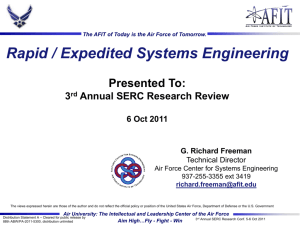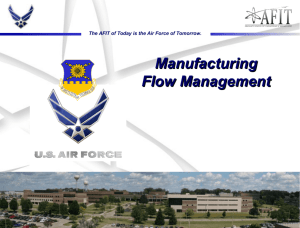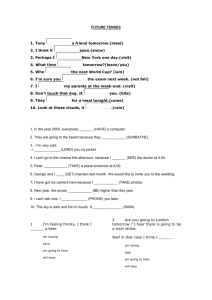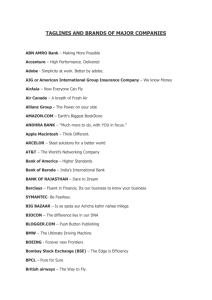The AFIT of Today is the Air Force of Tomorrow
advertisement
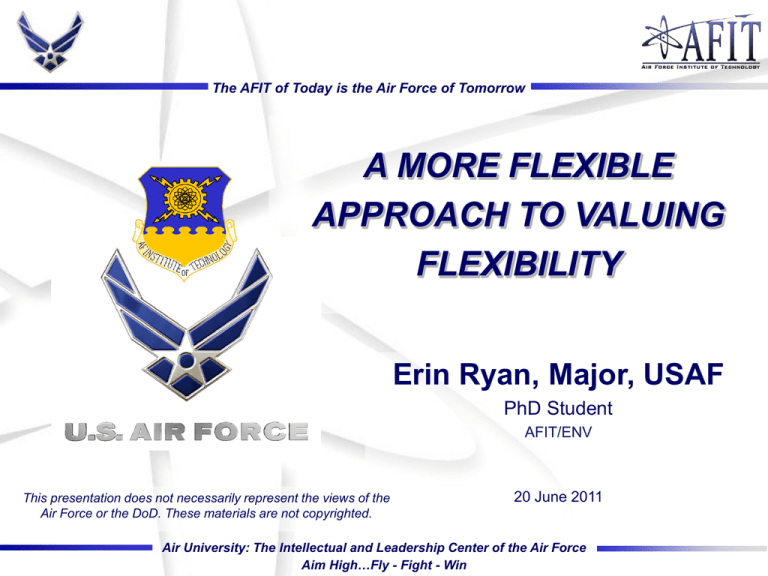
The AFIT of Today is the Air Force of Tomorrow A MORE FLEXIBLE APPROACH TO VALUING FLEXIBILITY Erin Ryan, Major, USAF PhD Student AFIT/ENV This presentation does not necessarily represent the views of the Air Force or the DoD. These materials are not copyrighted. 20 June 2011 Air University: The Intellectual and Leadership Center of the Air Force Aim High…Fly - Fight - Win Outline The AFIT of Today is the Air Force of Tomorrow ● DOD’s Ongoing Acquisition Challenges ● Uncertainty and the Need for Flexibility ● The Need to Justify Flexibility ● Challenges with Valuing Flexibility/Capabilities ● Proposed Valuation Methodology ● Current Expected Value Life Cycle Cost (CEVLCC) Model Air University: The Intellectual and Leadership Center of the Air Force Aim High…Fly - Fight - Win The Problem The AFIT of Today is the Air Force of Tomorrow ● GAO analysis of DOD’s major acquisition programs*— ● 69% reported an increase in total acquisition costs ● Over 40% of these programs had unit cost increase of at least 25% ● On average— ● R&D costs 42% higher than originally estimated ● 22 months behind planned schedule ● The older the program, the worse the trend ● Programs in development >15 yrs have seen an average 138% increase in acq costs, and over 36 mos of schedule delays *Source: GAO. 2009. DEFENSE ACQUISITIONS: Assessments of Selected Weapons Programs. Washington, D.C. Air University: The Intellectual and Leadership Center of the Air Force Aim High…Fly - Fight - Win The Historical Solution The AFIT of Today is the Air Force of Tomorrow ● Forty Years of Acq Reform— ● ● ● ● ● ● ● ● ● ● ● ● ● ● ● ● Fitzhugh Commission (1971) DODD 5000.01 (1972) DODI 5000.02 (1975) OMB Circular A-109 (1976) DSB Acquisition Cycle Task Force (1978) Defense Resource Management Study (1979) Carlucci Initiatives (1981) Nunn-McCurdy Thresholds (1982) Grace Commission (1983) Packard Commission/Goldwater-Nichols Act (1986) Defense Management Review (1989) DODI 5000.02 Revision (1991) Federal Acquisition Streamlining Act (1994) Clinger-Cohen Act (1996) Intelligence Reform and Terrorism Prevention Act (2004) Weapon Systems Acquisition Reform Act (2009) Air University: The Intellectual and Leadership Center of the Air Force Aim High…Fly - Fight - Win The Result The AFIT of Today is the Air Force of Tomorrow ● Little to no change in acq cost growth in last 3 decades ● Desired improvements are seldom, if ever, realized ● Why? ● Reform efforts largely aimed at cause rather than symptoms ● Exactly the right approach, unless root cause is inevitable ● Resources may actually be squandered— better off mitigating the impacts ● Can’t stop earthquakes, so we design earthquake-resistant structures ● For DOD acquisition programs, earthquake = uncertainty ● Increasing rate of change, and increasing system complexity Air University: The Intellectual and Leadership Center of the Air Force Aim High…Fly - Fight - Win Mitigating the Impacts The AFIT of Today is the Air Force of Tomorrow • Every major program must contend with myriad sources of uncertainty • Uncertainty cannot be overcome • Instead of tilting at the windmill of uncertainty, perhaps accept uncertainty as a fact of life, and explore how we can design systems to better respond to it Air University: The Intellectual and Leadership Center of the Air Force Aim High…Fly - Fight - Win Flexibility The AFIT of Today is the Air Force of Tomorrow • General term most often associated with ability to effectively respond to uncertainty is flexibility • If systems can be designed to more readily respond to sources of uncertainty/change, impact to program is lessened • Designing flexibility into a system may be vital to achieving elusive goal of improved cost & schedule performance • Frequent strategy in private industry, esp. in sectors characterized by high rates of uncertainty/change Air University: The Intellectual and Leadership Center of the Air Force Aim High…Fly - Fight - Win What is Flexibility? The AFIT of Today is the Air Force of Tomorrow ● Explored in CSER 2011 paper ● “Defining Flexibility and Flexibility-Related Terminology” ● May involve ● Design flexibility ● Process flexibility ● Adaptability ● Robustness ● Versatility ● Etc ● Specific definitions not important for this discussion ● “respond effectively to uncertainty” Air University: The Intellectual and Leadership Center of the Air Force Aim High…Fly - Fight - Win Investing in Flexibility The AFIT of Today is the Air Force of Tomorrow ● Current DOD acq structure would makes it very difficult to invest system flexibility ● DOD design trend is toward optimal performance ● More integrated, point-solution outcomes less capable of responding effectively to changing requirements ● Can’t justify spending money without a verified reqmnt ● Need to quantify its value in order to ascertain when and to what degree the investment in flexibility is worthwhile ● Need rational decision making methodology Air University: The Intellectual and Leadership Center of the Air Force Aim High…Fly - Fight - Win Decision Making Under Uncertainty The AFIT of Today is the Air Force of Tomorrow ● NPV ● Common method for determining time value of money ● Used in some studies (& some companies) to value flex ● Not favored by researchers for decisions involving flex ● Not effective in conditions of great uncertainty as it assumes a predetermined path thru an established set of alternatives Air University: The Intellectual and Leadership Center of the Air Force Aim High…Fly - Fight - Win Decision Making Under Uncertainty The AFIT of Today is the Air Force of Tomorrow ● Real Options ● Defined as the right, but not the obligation to take an action at a pre-determined cost and at a predetermined time ● Preferred approach by many scholars ● May not be suitable for DOD ● Black-Scholes (underlying financial model) requires valued asset be traded on “efficient” market, w/ no possibility of arbitrage ● Arguably true in broader capital market; not likely within the DOD, where markets are often artificial, and far from efficient ● B-S model assumes random fluctuation of price ● Dubious premise in standard market, let alone DOD Air University: The Intellectual and Leadership Center of the Air Force Aim High…Fly - Fight - Win Valuing Flexibility The AFIT of Today is the Air Force of Tomorrow ● Fundamentally, profit-centric valuation approaches not suitable for DOD systems ● The ROI is a political or military outcome ● Incommensurable units ● One side of equation is cost in dollars ● Other side of the equation is military outcome/capability ● A flexible system does not have intrinsic value— ● The capability associated with that flexibility that has value ● To assign value to flex, must assign value to military capability Air University: The Intellectual and Leadership Center of the Air Force Aim High…Fly - Fight - Win Valuing Capabilities The AFIT of Today is the Air Force of Tomorrow ● But how do we ascertain the monetized value of a military capability? ● Fly a little faster, fire round a bit farther, be a bit more stealthy, have slightly improved reliability… Air University: The Intellectual and Leadership Center of the Air Force Aim High…Fly - Fight - Win Valuing Capabilities The AFIT of Today is the Air Force of Tomorrow ● Willingness to Pay? ● Under neoclassic economic definition of value, item’s value can be established from customer’s willingness to pay ● In theory, value of a particular military capability could be determined from the maximum amount govt is willing to pay Air University: The Intellectual and Leadership Center of the Air Force Aim High…Fly - Fight - Win Valuing Capabilities The AFIT of Today is the Air Force of Tomorrow ● Use budgeted amount? ● Actual system cost may include other scarce resources not captured in govt budget (time, critical skills, facilities, etc) ● Need to account for opportunity cost ● E.g., losing/vitiating other capabilities by virtue of this investment ● Problem becomes recursive! ● Budgeted amount not necessarily max govt willing to pay ● Program budgets based on expected actual costs ● Budget allocation processes notoriously volatile, unrelated to the merits of particular program ● Defense budgets don’t cleanly map to capabilities ● No budgeted amount for non-baselined reqmnts/capabilities ● Perceived value of a capability may vary drastically! Air University: The Intellectual and Leadership Center of the Air Force Aim High…Fly - Fight - Win Valuing Capabilities The AFIT of Today is the Air Force of Tomorrow ● User Query? ● Inherent subjectivity ● Different users will perceive the value of a given capability differently ● Who to ask? How to weight responses? How to reconcile conflicts? ● End-users often not conversant in the language of budgets or possess meaningful insight into costs ● Flexible design options may not resonate with user ● Value of potential capabilities, vice validated ● Many ostensible benefits of design flexibility may be of great value to the acquirer, but of no consequence to the user ● Perceived value of a capability may vary drastically! Air University: The Intellectual and Leadership Center of the Air Force Aim High…Fly - Fight - Win An Alternative Approach The AFIT of Today is the Air Force of Tomorrow ● LCC as a proxy for value ● Refine current LCC calculations to better account for value of capability opportunities likely to arise in life of a program ● Though uncertainty not deterministic— ● May be possible to employ stochastic probability methods that can yield more accurate cost estimates ● More accurate LCC estimates (& accompanying improvement in decision-making) promises enormous ROI Air University: The Intellectual and Leadership Center of the Air Force Aim High…Fly - Fight - Win LCC Under Uncertainty The AFIT of Today is the Air Force of Tomorrow ● Key Assertions* ● The cost to develop, procure, & operate a system with some assured minimum capability over its lifecycle is not a deterministic value ● Instead, this cost can be modeled as a random variable with a probability distribution resulting from a set of uncertainties introduced throughout the system's life ● This random variable metric is a relevant basis for comparison between alternative system … design choices ● DARPA only considered launch and on-orbit failures ● Broader applicability not explored *Sources: Brown O., A. Long, et al. 2007. System Lifecycle Cost Under Uncertainty as a Design Metric Encompassing the Value of Architectural Flexibility. In AIAA Space 2007 Conference. 216-229; Brown O. and P. Eremenko. 2008. Application of Value-Centric Design to Space Architectures: The Case of Fractionated Spacecraft. Wash, D.C.: DARPA Air University: The Intellectual and Leadership Center of the Air Force Aim High…Fly - Fight - Win Stochastic, Dynamic LCC The AFIT of Today is the Air Force of Tomorrow ● Expand LCC under uncertainty idea to a robust and comprehensive methodology for effectively valuing various system design alternatives ● Extend to other sources of programmatic uncertainty ● New threats, technological setbacks/breakthroughs, reqmnt creep, test failures, budget fluctuations, market volatility, etc. ● Apply to lower-level design decisions ● Dynamic vice static ● Continually updated decision analysis tool ● Current Expected Value of Life Cycle Cost (CEVLCC) Air University: The Intellectual and Leadership Center of the Air Force Aim High…Fly - Fight - Win CEVLCC Methodology The AFIT of Today is the Air Force of Tomorrow 1. Establish system design options 2. Construct time-phased PDFs associated w/ all existing key cost, schedule, & tech performance parameters of program 3. Estimate costs associated with mods (consistent w/ PDFs) to baseline cost, schedule, & tech performance parameters 4. Assign time-phased probabilities for potential new capabilities of the system 5. Estimate costs associated w/ the addition of new capabilities 6. Calculate standard (i.e., traditional) LCC estimate 7. Calculate CEVLCC for each system design option and select alternative with the lowest CEVLCC Air University: The Intellectual and Leadership Center of the Air Force Aim High…Fly - Fight - Win Marginal Probability Costs The AFIT of Today is the Air Force of Tomorrow PDF Marginal Cost Threshold (X) 96.0% 96.5% 97.0% 97.5% Marginal Probability Cost 98.0% 98.5% 99.0% 96.5% 99.9% Threshold Parameter Air University: The Intellectual and Leadership Center of the Air Force Aim High…Fly - Fight - Win 21 CEVLCC Equation The AFIT of Today is the Air Force of Tomorrow Marginal Probability Costs for Modifiable Capabilities Marginal Probability Costs for New Capabilities 𝑚 𝑪𝑬𝑽𝑳𝑪𝑪 = 𝑳𝑪𝑪 + b 𝑛 𝐸(𝑋)𝑖 + (1 − b) 𝑖=1 Standard LCC The system that is the best value is simply the one with the lowest CEVLCC 𝐸 𝑌 𝑖 𝑖=1 Probabilistic value b = weighting factor m = no. of modifiable capabilities n = no. of new capabilities Air University: The Intellectual and Leadership Center of the Air Force Aim High…Fly - Fight - Win 22 Potential Challenges The AFIT of Today is the Air Force of Tomorrow ● Nature of DOD acq may be more chaotic than stochastic ● Would prevent accurate predictive modeling over a reasonable time horizon ● MPC models would need to be comprehensive/current ● May be overly cumbersome, and investment cost likely to outweigh benefits at some point in program life ● Only applies to foreseeable sources of change ● Only valid to compare design options that meet threshold reqmnt levels ● Does not entirely sidestep problem of valuing capability ● Design option performance greater than threshold (but less than objective) has temporal and intrinsic (to user) value Air University: The Intellectual and Leadership Center of the Air Force Aim High…Fly - Fight - Win Summary The AFIT of Today is the Air Force of Tomorrow ● Uncertainty leads to cost/schedule overruns ● Only so much we can do to mitigate uncertainty ● Need to be able to respond effectively to it, i.e., have flexibility ● Difficult to justify the required investment in flexibility ● Need to quantify value of flex => quantify value of capability ● Not feasible to quantify military capabilities, so need alternate approach capable of evaluating design options strategically ● Current Expected Value Life Cycle Cost (CEVLCC) ● Top-down, intrinsic value model based on familiar notion of LCC ● The need for capability changes in a program arises in a stochastic manner that can be modeled & incorporated into continually updated, expected value model of total program cost Air University: The Intellectual and Leadership Center of the Air Force Aim High…Fly - Fight - Win BACKUPS The AFIT of Today is the Air Force of Tomorrow Air University: The Intellectual and Leadership Center of the Air Force Aim High…Fly - Fight - Win 25 CEVLCC Assumptions The AFIT of Today is the Air Force of Tomorrow 1. As programs mature, there will be unpredictable deviations from the program baseline that affect the system’s LCC 2. An improved LCC estimate is possible thru probabilistic modeling of the stochastic processes that cause deviations 3. The required investment cost to calculate an improved LCC estimate is more than offset by the value obtained 4. Given the CEVLCC cost accounting methodology, as long as each design meets all of its threshold requirements, then its relative value can be inferred from its cost Air University: The Intellectual and Leadership Center of the Air Force Aim High…Fly - Fight - Win Research Steps The AFIT of Today is the Air Force of Tomorrow 1. Characterize Accuracy of existing LCCs ● Compare predicted costs to actuals 2. Build & Characterize Default CEVLCC Model ● Determine which (and to what extent) MDAP parameters have statistically significant relationships w/ actual LCC 3. Build & Characterize Program-Specific CEVLCC Model ● Modify Default CEVLCC Model to incorporate MPCs into its prediction algorithm(s) 4. Evaluate Utility of CEVLCC Models • Assess broad-based utility of both models by comparing their cost to value over a wide range of usage parameters Air University: The Intellectual and Leadership Center of the Air Force Aim High…Fly - Fight - Win An Alternative Approach The AFIT of Today is the Air Force of Tomorrow ● A Better Solution Would Be Able To— ● Establish the merits of a capability without having to explicitly determine its value ● Inherently assimilate various capability concepts, merging them into a single solution space effectively responds to uncertainty ● Being comprised of concepts already familiar to the acquisition community (i.e., life cycle cost and risk analysis), thereby greatly reducing cultural entry barriers ● Having a simple premise and an intuitive output (i.e., cost), both of which encourage adoption among stakeholders across the acquisition community Air University: The Intellectual and Leadership Center of the Air Force Aim High…Fly - Fight - Win
